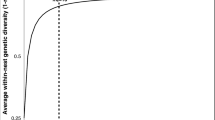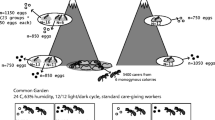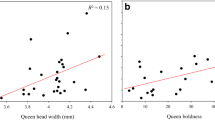Abstract
High relatedness among society members is believed important for the evolution of highly cooperative behaviours, yet queens of many social insects mate with multiple males which reduces nestmate relatedness and imposes also direct costs on queens. While theoretical models have suggested explanations for this puzzling queen behaviour, empirical studies fail to provide consistent answers especially for species with moderate levels of multiple mating. This may result from multiple mating only conferring benefits in some environments, as suggested by recent genetic variance theory and considerations on types of traits, direct costs and benefits. All concur in an expectation of higher levels of multiple mating in more complex or milder environments, and we perform a first, broad test of this idea by comparing mating strategies of queens in Lasius niger ants from northern (harsh, cold stressed) and southern populations (milder, greater bio-complexity). First, we collected new genetic data from Ireland and Southern France and then compared these to data on Swiss and Swedish populations. Queens from northern populations were near exclusively single mated and even at times inbred (in Ireland), whereas southern queens showed high levels of multiple mating, leading to more genetically diverse colonies in the south. Equally, paternity skew was greater in the north, as expected if northern queens only remate when their first mate transfers few sperm. Our findings are consistent with the idea that environment type may affect mating strategies in social insects and calls for an exploration of such effects.





Similar content being viewed by others
References
Aron S, Passera L, Keller L (1999) Evolution of social parasitism in ants: size of sexuals, sex ratio and mechanisms of caste determination. Proc R Soc Lond B 266:173–177
Baer B, Armitage SAO, Boomsma JJ (2006) Sperm storage induces an immunity cost in ants. Nature 441:872–875
Boomsma JJ, Kronauer DJC, Pedersen JS (2009) The evolution of social insect mating systems. In: Gadau J, Fewell J (eds) Organization of insect societies—from genomes to socio-complexity. Harvard University Press, Cambridge Massachusetts, pp 3–25
Boomsma JJ, Ratnieks FLW (1996) Paternity in eusocial Hymenoptera. Proc R Soc Lond B 351:947–975
Boomsma JJ, Van Der Have TA (1998) Queen mating and paternity variation in the ant Lasius niger. Mol Ecol 7:1709–1718
Boomsma JJ, van der Lee GA, van der Have TA (1982) On the production ecology of Lasius niger (Hymenoptera: Formicidae) in successive coastal dune valleys. J Anim Ecol 51:975–991
Castella G, Christe P, Chapuisat M (2009) Mating triggers dynamic immune regulations in wood ant queens. J Evol Biol 22:564–570
Cole BJ (1983) Multiple mating and the evolution of social behavior in the Hymenoptera. Behav Ecol Sociobiol 12:191–201
Cole BJ, Wiernasz DC (1999) The selective advantage of low relatedness. Science 285:891–893
Crozier RH, Fjerdingstad EJ (2001) Polyandry in social Hymenoptera—disunity in diversity? Ann Zool Fennici 38:267–285
Crozier RH, Page RE (1985) On being the right size: male contributions and multiple mating in social Hymenoptera. Behav Ecol Sociobiol 18:105–115
Crozier RH, Pamilo P (1996) Evolution of social insect colonies: sex allocation and kin selection. Oxford University Press, Oxford
Fjerdingstad EF (2004) Multiple paternity and colony homeostasis in Lasius niger ants. Behav Ecol Sociobiol 56:50–58
Fjerdingstad EF, Boomsma JJ, Thorén P (1998) Multiple paternity in the leafcutter ant Atta colombica—a microsatellite DNA study. Heredity 80:118–126
Fjerdingstad EJ, Crozier RH (2006) The evolution of worker caste diversity in social insects. Am Nat 167:390–400
Fjerdingstad EF, Gertsch EP, Keller L (2002) Why do some social insect queens mate with several males? Testing the sex-ratio manipulation hypothesis in Lasius niger. Evolution 56:553–562
Fjerdingstad EJ, Gertsch PJ, Keller L (2003) The relationship between multiple mating by queens, within-colony genetic variability and fitness in the ant Lasius niger. J Evol Biol 16:844–853
Gaston KJ (2000) Global patterns in biodiversity. Nature 405:20–227
Gove R, Hayworth M, Chhetri M, Rüppell O (2009) Division of labour and social insect colony performance in relation to task and mating number under two alternative response threshold models. Insect Soc 56:319–331
Goudet J (1995) Fstat version 1.2: a computer program to calculate Fstatistics. J Hered 86:485–486
Hamilton WD (1964) The genetic evolution of social behavior. I. J Theor Biol 7:1–52
Hughes WOH, Boomsma JJ (2004) Genetic diversity and disease resistance in leaf-cutting ant societies. Evolution 58:1251–1260
Hughes WOH, Sumner S, van Borm S, Boomsma JJ (2003) Worker caste polymorphism has a genetic basis in Acromyrmex leaf-cutting ants. Proc Natl Acad Sci USA 10016:9394–9397
Hughes WOH, Oldroyd BP, Beekman M, Ratnieks FLW (2008) Ancestral monogamy shows kin selection is key to the evolution of eusociality. Science 320:1213–1216
Jaffe R, Kronauer DJC, Kraus FB, Boomsma JJ, Moritz RFA (2007) Worker caste determination in the army ant Eciton burchellii. Biol Lett 3:513–516
Jones JC, Myerscough MR, Graham S, Oldroyd BP (2004) Honey bee nest thermoregulation: diversity promotes stability. Science 305:402–404
Keller L, Reeve HK (1994) Genetic variability, queen number, and polyandry in social Hymenoptera. Evolution 48:694–704
Kipyatkov VE, Lopatina EB, Imamgaliev AA, Shirokova LA (2004) Effect of temperature on rearing of the first brood by the founder females of the ant Lasius niger (Hymenoptera, Formicidae): Latitude-dependent variability of the response norm. J Evol Biochem Physiol 40:165–175
Kraus B, Page RE (1998) Parasites, pathogens, and polyandry in social insects. Am Nat 151:383–391
Kraus FB, Neumann P, van Praagh J, Moritz RFA (2004) Sperm limitation and the evolution of extreme polyandry in honeybees (Apis mellifera L.). Behav Ecol Sociobiol 55:494–501
Kronauer DJC, Johnson RA, Boomsma JJ (2007) The evolution of multiple mating in army ants. Evolution 61:413–422
Mattila HR, Seeley TD (2007) Genetic diversity in honeybee colonies enhances productivity and fitness. Science 317:362–364
Moilanen A, Sundström L, Pedersen J-S (2004) MATESOFT: a program for deducing parental genotypes and estimating mating system statistics in haplodiploid species. Mol Ecol Notes 4:795–797
Moret Y, Schmid-Hempel P (2004) Social life-history response to individual immune challenge of workers of Bombus terrestris L.: a possible new cooperative phenomenon. Ecol Lett 7:146–152
Nielsen R, Tarpy DR, Reeve HK (2003) Estimating effective paternity number in social insects and the effective number of alleles in a population. Mol Ecol 12:3157–3164
Nonacs P (2000) Measuring and using skew in the study of social behavior and evolution. Am Nat 156:577–589
Nonacs P (2003). Skew Calculator. http://www.eeb.ucla.edu/Faculty/Nonacs/shareware.htm, University of California at Los Angeles. Accessed Apr 2010
Oldroyd BP, Fewell JH (2007) Genetic diversity promotes homeostasis in insect colonies. Trends Ecol Evol 22:408–413
Page RE (1986) Sperm utilization in social insects. Ann Rev Entomol 31:297–320
Pamilo P (1993) Polyandry and allele frequency difference between the sexes in the ant Formica aquilonia. Heredity 70:472–480
Pearcy M, Timmermans I, Allard D, Aron S (2009) Multiple mating in the ant Cataglyphis cursor: testing the sperm limitation and the diploid male load hypotheses. Insect Soc 56:94–102
Pedersen JS, Boomsma JJ (1999) Positive association of queen number and queen-mating frequency in Myrmica ants: a challenge to the genetic-variability hypotheses. Behav Ecol Sociobiol 45:185–193
Queller DC, Goodnight KF (1989) Estimating relatedness using genetic markers. Evolution 43:258–275
Ratnieks FLW, Boomsma JJ (1995) Facultative sex allocation by workers and the evolution of polyandry by queens in social Hymenoptera. Am Nat 145:969–993
Raymond M, Rousset F (1995) GENEPOP. 1.2: A population genetics software for exact tests and ecumenism. J Hered 86:248–249
Rüppell O, Johnson N, Rychtár J (2008) Variance-based selection may explain general mating patterns in social insects. Biol Lett 4:270–273
Schmid-Hempel P (1998) Parasites in social insects. Princeton University Press, Princeton
Seeley TD, Tarpy DR (2007) Queen promiscuity lowers disease within honeybee colonies. Proc R Soc B 274:67–72
Seifert B (1992) A taxonomic revision of the Palaearctic members of the ant subgenus Lasius s. str. (Hymenoptera: Formicidae). Abh Ber Naturkundemus Görlitz 66:1–67
Sherman PW, Seeley TD, Reeve HK (1988) Parasites, pathogens, and polyandry in social Hymenoptera. Am Nat 131:602–610
Stearns SC (1992) The evolution of life histories. Oxford University Press, Oxford
Sundström L, Ratnieks FLW (1998) Sex ratio conflicts, mating frequency, and queen fitness in the ant Formica truncorum. Behav Ecol 9:116–121
Tarpy DR (2003) Genetic diversity within honeybee colonies prevents severe infections and promotes colony growth. Proc R Soc Lond B 270:99–103
Trontii K, Thurin N, Sundström L, Aron S (2007) Mating for convenience or genetic diversity? Mating patterns in the polygynous ant Plagiolepis pygmaea. Behav Ecol 18:298–303
van Osterhout C, Hutchinson WF, Wills DPM, Shipley P (2004) MICRO-CHECKER: software for identifying and correcting genotyping errors in microsatellite data. Mol Ecol Notes 31:535–538
Verhoeven KJF, Simonsen KL, McIntyre LM (2005) Implementing false discovery rate control: increasing your power. Oikos 108:643–647
Wenseleers T, Ratnieks FLW, Billen J (2003) Caste fate conflict in swarm-founding social Hymenoptera: an inclusive fitness analysis. J Evol Biol 16:647–658
Wiernasz DC, Hines J, Parker DG, Cole BJ (2008) Mating for variety increases foraging activity in the harvester ant, Pogonomyrmex occidentalis. Mol Ecol 17:1137–1144
Acknowledgments
Our work was funded by a start up grant to E.J.F. from Queens College of the City University of New York (CUNY), a Professional Staff Congress of CUNY Research Award to E.J.F. (grant #61208-00 39) and a Queens College Research Enhancement Award to E.J.F. (grant #90927-08-08). Part of our work was carried out using equipment at the core facility of the Biology Department at Queens College, CUNY. We would like to thank A. Tsiola for storing samples, G.W. Jackman for help with the DNA extractions, P. Nonacs for assistance with the Skew Calculator, and W.O.H. Hughes, D.C. Kronauer, M. Baker, D. Lohman and two anonymous reviewers for their valuable comments on earlier versions of this paper.
Ethical standards
The experiments described here complied with current laws of the European Union and the United States of America.
Conflict of interest
None.
Author information
Authors and Affiliations
Corresponding author
Additional information
Communicated by O. Rueppell
Rights and permissions
About this article
Cite this article
Corley, M., Fjerdingstad, E.J. Mating strategies of queens in Lasius niger ants—is environment type important?. Behav Ecol Sociobiol 65, 889–897 (2011). https://doi.org/10.1007/s00265-010-1089-7
Received:
Revised:
Accepted:
Published:
Issue Date:
DOI: https://doi.org/10.1007/s00265-010-1089-7




